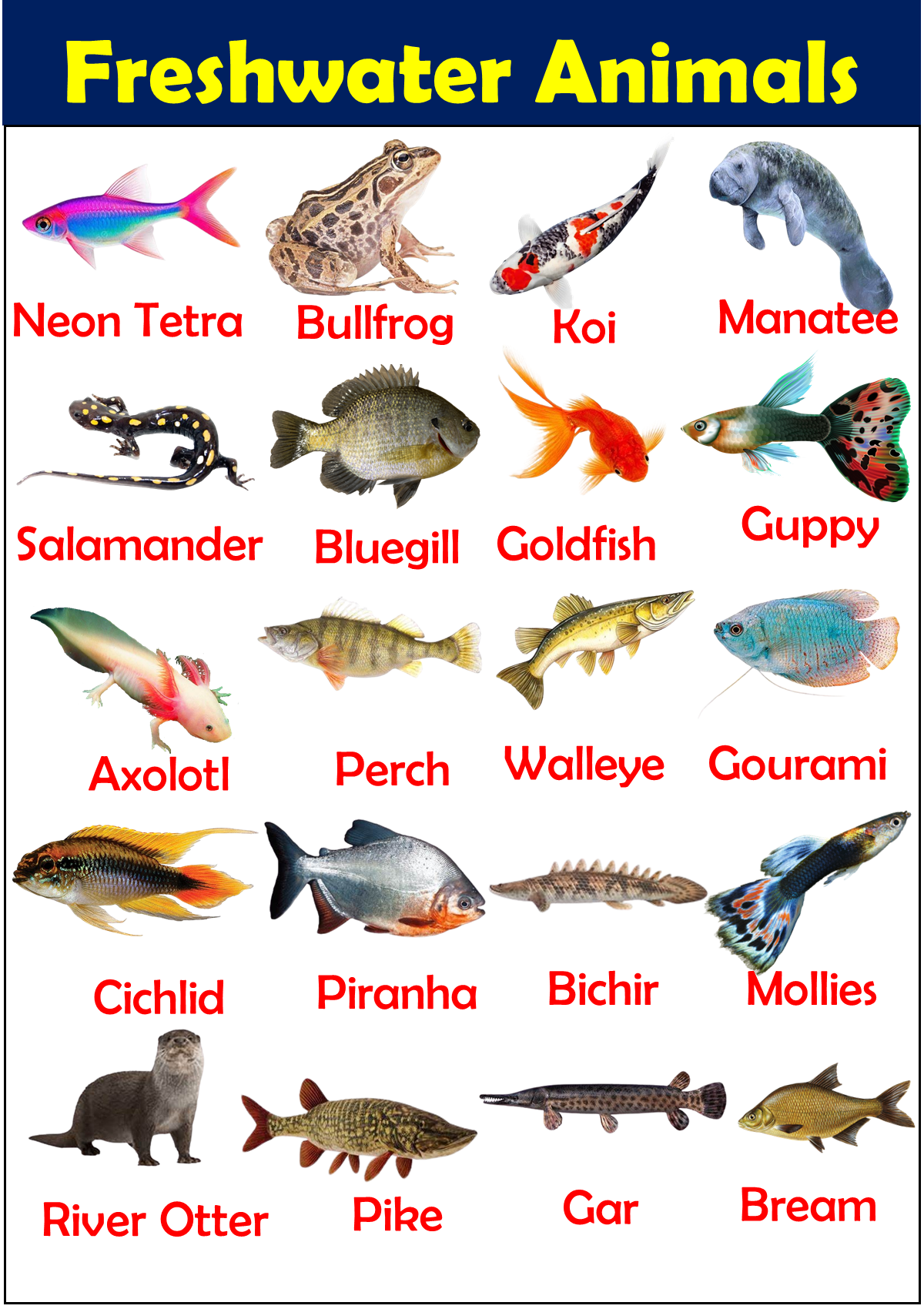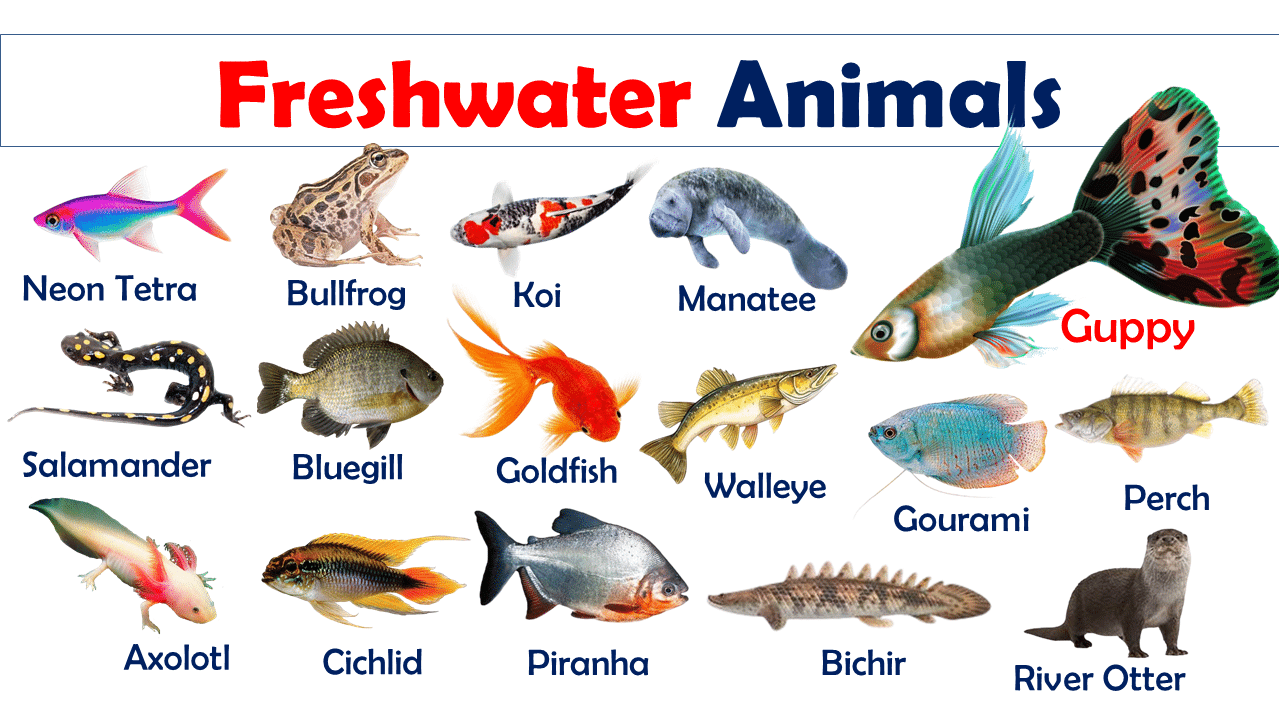Freshwater Animals like Rivers, lakes, and streams are like nature’s playgrounds for all sorts of fascinating animals. In this blog post, we’ll dive into the world of freshwater animals, discovering creatures that swim, crawl, and even hop along the water’s edge. You’ll learn about different species, what makes them special, and how they manage to thrive in watery habitats. Get ready to expand your English vocabulary with fun and interesting words about these amazing animals. Let’s jump in and splash around in the world of freshwater wildlife!
What are Freshwater Animals?
Freshwater animals are species that live in non-saline inland waters such as lakes, rivers, ponds, and streams. These environments support a wide range of animals that are adapted to less salty water, making them different from marine organisms. Freshwater ecosystems are crucial for biodiversity, supporting species that are unique to these habitats.
List of Freshwater Animals
- Freshwater Crocodile
- Otter
- Manatee
- Freshwater Dolphin
- Beaver
- Water Vole
- Platypus
- Electric Eel
- Piranha
- Catfish
- Carp
- Salmon
- Trout
- Perch
- Pike
- Sturgeon
- Crayfish
- Freshwater Clam
- Freshwater Pearl Mussel
- Water Snail
- Water Flea
- Dragonfly Larvae
- Damselfly Larvae
- Mayfly Larvae
- Caddisfly Larvae
- Freshwater Jellyfish
- Freshwater Sponge
- Diving Beetle
- Whirligig Beetle
- Mosquito Larvae
- Mudpuppy
- Axolotl
- Newt
- Bullfrog
- Green Frog
- Water Scorpion
- Freshwater Crab
- Freshwater Shrimp
- Glassfish
- Siamese Fighting Fish (Betta)
- Guppy
- Mollies
- Goldfish
- Koi
- Gourami
- Discus
- Neon Tetra
- Angelfish
- Walleye
- Shiner
- Sunfish
- Bream
- African Lungfish
- Gar
- Bowfin
- Coelacanth
- Giant Salamander
- Hippopotamus
- River Turtle
- Softshell Turtle
- Duck
- Goose
- Swan
- River Otter
- Water Buffalo
- Snapping Turtle
- Leech
- Freshwater Stingray
- Anaconda
- Marsh Frog
Explore More Animal Vocab:

Freshwater Animals Vocabulary
1. Freshwater Crocodile
The freshwater crocodile, also known as the “freshie,” is native to northern Australia. It is smaller and less aggressive than its saltwater counterpart, primarily feeding on fish, amphibians, and small mammals. Freshwater crocodiles are known for their lighter color and narrower snout.
2. Otter
Otters are playful mammals that inhabit rivers and lakes. They have streamlined bodies, webbed feet, and thick fur to keep warm. Otters are excellent swimmers and are often seen sliding on muddy or icy patches as part of their playful behavior.
3. Manatee
Manatees, often referred to as sea cows, are large, gentle marine mammals that inhabit freshwater rivers, estuaries, and coastal marine waters. They are herbivores, grazing on water plants and can consume up to 10-15% of their body weight daily.
4. Freshwater Dolphin
The Amazon River dolphin or pink river dolphin is a freshwater dolphin species found in the Amazon and Orinoco river systems. It is notable for its pink coloration and extremely flexible neck, which allows it to navigate through complex underwater environments.
5. Beaver
Beavers are known for their natural skill at building dams on rivers and streams using tree branches and mud. These constructions create wetlands beneficial for numerous other species, including fish, birds, and amphibians. Beavers have a significant impact on their ecosystem, often altering the landscape dramatically.
6. Water Vole
The water vole is one of Europe’s largest vole species, found along rivers, streams, and lakes. It is a critical indicator species for the health of riverine environments but has faced declines due to habitat loss and predation by invasive American mink.
7. Platypus
The platypus is an extraordinary mammal native to eastern Australia, including Tasmania. It lays eggs, and males have venomous spurs on their hind limbs, making it one of the few venomous mammals. The platypus is equipped with electroreceptors to locate prey underwater.
8. Electric Eel
Despite its name, the electric eel is not an eel but a knifefish. Found in South American rivers, it can generate powerful electric shocks up to 600 volts for hunting and self-defense. It primarily feeds on invertebrates, small fish, and amphibians.
9. Piranha
Piranhas are notorious for their sharp teeth and a reputation for a ferocious appetite for meat. Found in South America’s freshwater rivers, they mainly feed on fish, although exaggerated accounts suggest they can strip large animals to the bone.
10. Catfish
Catfish are characterized by their barbels, which resemble a cat’s whiskers. These sensory organs help them to find food in murky waters. There are many species of catfish across the globe, varying greatly in size and habitat.
11. Carp
Carp are adaptable, hardy fish that inhabit rivers, lakes, and ponds across the world. They can become invasive outside their native ranges, often outcompeting local species for resources. Carp are popular among anglers and in aquaculture.
12. Salmon
Salmon are anadromous, meaning they are born in freshwater, migrate to the ocean, then return to freshwater to reproduce. This journey is hazardous, fraught with predators and geographical obstacles, but is essential for their lifecycle.
13. Trout
Trout are closely related to salmon and share a similar habitat and lifecycle, although many species are primarily freshwater. They are popular game fish, known for their fight when hooked and delicious taste.
14. Perch
Perch is a common name for several species of freshwater fish that are often brightly colored, especially during the breeding season. They are popular in recreational fishing and valued for their taste.
15. Pike
Pike are predatory fish known for their elongate bodies and sharp teeth, making them formidable hunters. They are commonly found in the temperate regions of the Northern Hemisphere and are sought after as game fish.
16. Sturgeon
Sturgeons are large, long-lived fish, famous for producing caviar, which is made from their unfertilized eggs. They inhabit temperate waters in Eurasia and North America and are critically endangered due to overfishing and habitat loss.
17. Crayfish
Crayfish, also known as crawfish or crawdads, are freshwater crustaceans resembling small lobsters, to which they are related. They are found in running waters where they feed on plants and animals, both living and decomposing.
18. Freshwater Clam
Freshwater clams filter water to feed and breathe, thus playing a crucial role in maintaining water clarity and quality. They are sensitive to pollution and are often used as indicators of environmental health.
19. Freshwater Pearl Mussel
This species of mussel is known for producing pearls and is found in clean, fast-flowing rivers and streams across the northern hemisphere. They are highly sensitive to water pollution and are endangered due to habitat loss and pollution.
20. Water Snail
Water snails are common in freshwater habitats, where they play a role in the ecosystem as grazers on algae and as prey for a variety of larger species. They can also be indicators of water quality.
21. Water Flea
Water fleas are tiny crustaceans that are crucial to freshwater ecosystems as they feed on algae and serve as a major food source for many larger aquatic species. They are often used in scientific studies due to their rapid reproductive rates.
22. Dragonfly Larvae
Dragonfly larvae, also known as nymphs, are aquatic predators feeding on other invertebrates and even small fish. They undergo metamorphosis to become the flying adults known for their aerial acrobatics.
23. Damselfly Larvae
Similar to dragonfly larvae but generally smaller and more slender, damselfly larvae are also important aquatic predators. They eventually emerge from the water to undergo metamorphosis into flying adults.
24. Mayfly Larvae
Mayfly larvae live in water for about a year, feeding on algae and organic debris. They are known for their extremely short adult lives, sometimes lasting only a few hours, during which their sole purpose is to reproduce.
25. Caddisfly Larvae
Caddisfly larvae are known for constructing protective cases out of silk and environmental materials like sand or plant debris. They are important bioindicators and a key part of freshwater ecosystems.
26. Freshwater Jellyfish
The freshwater jellyfish is a small species that is mostly harmless to humans. It can occasionally bloom in large numbers in ponds and calm river sections. Despite its delicate appearance, it is a carnivorous predator feeding on tiny aquatic animals.
27. Freshwater Sponge
Freshwater sponges form colonies that can cover large areas under the water. They filter particles out of the water, feeding on bacteria and tiny organic particles, thus contributing to the cleanliness of their environment.
28. Diving Beetle
Diving beetles are predators, capturing other invertebrates and even small fish. They carry air bubbles under their wings when they dive, allowing them to stay underwater for prolonged periods.
29. Whirligig Beetle
Whirligig beetles are known for their gregarious behavior, swimming in large groups on the water’s surface. They have divided eyes that allow them to see above and below the water simultaneously.
30. Mosquito Larvae
Mosquito larvae are aquatic and breathe through siphons at the end of their abdomens. They are an important food source for many different fish and birds, despite the adult’s role in spreading diseases among humans.
